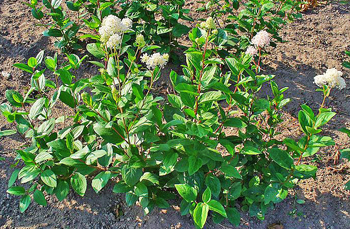Contents:
Common Names | Parts Usually Used | Plant(s) & Culture | Where Found | Medicinal Properties | Biochemical Information
Legends, Myths and Stories | Uses | Formulas or Dosages | Bibliography
Scientific Names

- Ceanothus americanus L.
- Rhamnaceae
- Buckthorn family
Common Names
- Bobea
- Jersey tea
- New Jersey tea tree
- Red root
- Walpole tea
- Wild snowball
Parts Usually Used
Bark of the root
Back to Top
Description of Plant(s) and Culture
New Jersey tea is a small, low, bushy, deciduous shrub 1-2 feet tall; the large root is red inside and is covered with brownish or reddish bark. The round, slender, reddish stems bear alternate, ovate or oblong-ovate, finely serrate leaves which are dull green on top, 2 inches long with 3 prominent parallel veins, and finely hairy beneath. Small, white, showy flowers grow in dense, long-stalked, cylindrical, clusters from the axils which form large panicles at the ends of the branches from June to August.
The three-celled drupaceous fruit when dry separate into three stone-like seeds.
Back to Top
Where Found
Common in dry, gravely banks, open woods at low elevations, in well-drained coarse soils all across the United States. Maine to Florida; Oklahoma to Minnesota.
Back to Top
Medicinal Properties
Astringent, expectorant, sedative
Back to Top
Biochemical Information
Ceanothic (emmolic), succinic, oxalic, malonic, malic, orthophosphic, and pyrophosphoric acids; 8% tannin in the root
Back to Top
Legends, Myths and Stories
The nearest American plant equivalent in flavor to oriental tea. Contains no harmful stimulants, thus is an excellent tea substitute. Used during the American Revolution for this purpose.
New Jersey tea got its name from the fact that the leaves of it were used as a tea by the soldiers in the American Revolution and early settlers in the United States.
Back to Top
Uses
The leaf tea is a popular beverage. Native Americans used root tea for colds, fevers, snakebites, stomachaches, lung ailments, laxative, blood tonics.
The root bark tea has been recommended for various chest problems, including chronic bronchitis, nervous asthma, whooping cough, despondency and melancholy, lymphatic congestion, and consumption. Used as a gargle for inflammation of the throat, fever, and irritations of the mouth, particularly tonsillitis.
Alkaloid in the root mildly Hypotensive; lowers blood pressure.
Native Americans used a tea made from the whole plant for skin problems, skin cancer, and venereal sores. Good for dysentery, piles, is effective in syphilis and gonorrhea. Combined with fringe tree and goldenseal, it is good for sick headache, acute indigestion, and nausea due to poor activity of the liver.
Back to Top
Formulas or Dosages
Use dried bark from the roots. Dried leaves are used to make tea.
Infusion: steep 1 tsp. root-bark in 1 cup water. Take 1 to 2 cups a day.
Decoction: take 1/2 tsp. powdered herb in 1 cup cold water, take 1 hour before each meal and before going to bed.
If capsules are used, take one No. 00 capsule before meals and at bedtime.
Tincture: take 10 to 20 drops in water, 3-4 times a day.
Back to Top
Bibliography
![]() Back to Eden
Back to Eden, by Jethro Kloss; Back to Eden Publishing Co., Loma Linda, CA 92354, Original copyright 1939, revised edition 1994
![]() The Herb Book
The Herb Book, by John Lust, Bantam Books, 666 Fifth Avenue, New York, NY. copyright 1974.
![]() Eastern/Central Medicinal Plants
Eastern/Central Medicinal Plants, by Steven Foster and James A. Duke., Houghton Mifflin Company, 215 Park Avenue South, New York, NY 10000
Herbal Gardening, compiled by The Robison York State Herb Garden, Cornell Plantations, Matthaei Botanical Gardens of the University of Michigan, University of California Botanical Garden, Berkeley., Pantheon Books, Knopf Publishing Group, New York, 1994, first edition
![]() Planetary Herbology
Planetary Herbology, by Michael Tierra, C.A., N.D., O.M.D., Lotus Press, PO Box 325, Twin Lakes. WI 53181., Copyright 1988, published 1992
![]() Indian Herbalogy of North America
Indian Herbalogy of North America, by Alma R. Hutchens, Shambala Publications, Inc., Horticultural Hall, 300 Massachusetts Avenue, Boston, Massachusetts 02115, 1973
![]() American Folk Medicine
American Folk Medicine, by Clarence Meyer, Meyerbooks, publisher, PO Box 427, Glenwood, Illinois 60425, 1973
 How Indians Use Wild Plants for Food, Medicine & Crafts
How Indians Use Wild Plants for Food, Medicine & Crafts, by Frances Densmore, Dover Publications, Inc., 180 Varick Street, New York, NY 10014, first printed by the United States Government Printing Office, Washington, in 1928, this Dover edition 1974
![]() Webster’s New World Dictionary
Webster’s New World Dictionary, Third College Edition, Victoria Neufeldt, Editor in Chief, New World Dictionaries: A Division of Simon & Schuster, Inc., 15 Columbus Circle, New York, NY 10023
 How Indians Use Wild Plants for Food, Medicine & Crafts
How Indians Use Wild Plants for Food, Medicine & Crafts, by Frances Densmore, Dover Publications, Inc., 180 Varick Street, New York, NY 10014, first printed by the United States Government Printing Office, Washington, in 1928, this Dover edition 1974
 An Instant Guide to Medicinal Plants
An Instant Guide to Medicinal Plants, by Pamela Forey and Ruth Lindsay, Crescent Books (January 27, 1992).
![]() The Yoga of Herbs: An Ayurvedic Guide to Herbal Medicine
The Yoga of Herbs: An Ayurvedic Guide to Herbal Medicine, by Dr. David Frawley & Dr. Vasant Lad, Lotus Press, Twin Lakes, Wisconsin, Second edition, 1988.
 The Rodale Herb Book: How to Use, Grow, and Buy Nature’s Miracle Plants (An Organic gardening and farming book)
The Rodale Herb Book: How to Use, Grow, and Buy Nature’s Miracle Plants (An Organic gardening and farming book), edited by William H. Hylton, Rodale Press, Inc. Emmaus, PA, 18049., 1974
